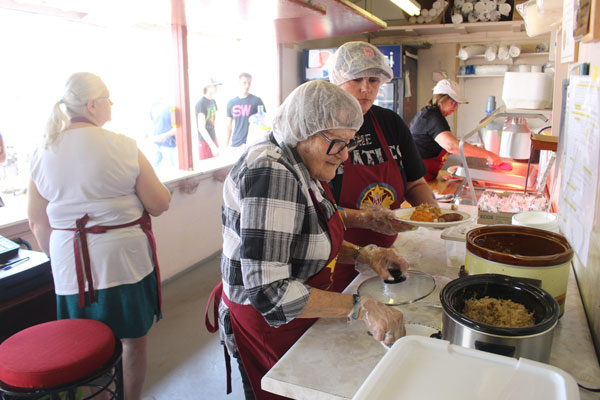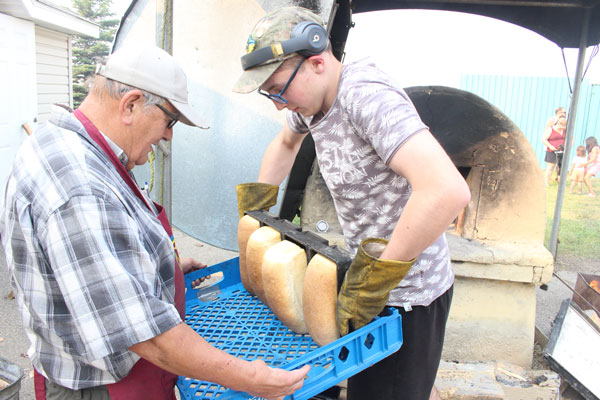
The Prince Albert Exhibition features many food booths run by local organizations each year.
One of the more popular is the Veselka Ukrainian Cultural and Heritage Club booth. The Veselka booth is busy through the whole week of the Exhibition serving Ukrainian food including borscht as well as making fresh bread in their clay oven.
Olga Karasiuk is a volunteer with a variety of organizations but came aboard this year to help serve at the Veselka.
“This is my first year volunteering (and) I’m enjoying it very much,” Karasiuk said. “We have been very busy and everybody is cooperating.”
The Veselka executive of Marj Bodnarrchuk, Zenik Rabiej, Jean Rabiej, and Jan Olesko helps to organize volunteers each year and Bodnarchuk brought Karasiuk into the fold this year. In the past, she’s volunteers with Polkafest, and got to know PA Citizen of the Year Marj Bodnarchuk through that event. Bodnarchuk also volunteered with Veselka, and that convinced Karasiuk to start helping the organization too.
“Here I am and I am really enjoying it,” she said. “I’m very sorry that I haven’t been doing it before.”
The Veselka food booth also has started a tradition of having celebrity volunteers. This year they included Prince Albert MLAs Joe Hargrave and Alana Ross and Member of Parliament Randy Hoback. Ross was working her second shift to close out the Exhibition on Saturday. The celebrity concept came from Olesko and Bodnarchuk over the past two years.
“I think I think it’s very good, they are all very good workers,” Karasiuk said.
Hoback also took a turn assisting with the bread part or the operation.
A portion of the proceeds from the Veselka booth will be donated to the Canada-Ukraine Foundation to support humanitarian relief to those impacted by the war in Ukraine. The Vesleka booth also fundraises for other Veselka organization activities.
Karasiuk encouraged everyone to come back for the Exhibition.
“Make sure that you all come out next year. We have great food,” Karasiuk said.

Zenik Rabiej and his young apprentice from Ukraine were in charge of the clay oven bread on Saturday.
“I organize a schedule for all day for all this and got the workers for the week. I pretty well spent the whole week here,” Rabiej said.
The bread-making is a meticulous process according to Rabiej, with the oven having to be brought to a correct heat of around 475 degrees.
“We put the bread in there and right now it looks like it’s about 500 degrees,” he explained. “We have a batch that’s going to be put in there in about half-hour, 40 minutes when the bread rises enough, we take those coals out and drag them out.”
The coals are dragged out into a metal box with a special tool and they try to reach the special temperature before the pans of bread are placed in the oven.
“We try to get it at around 475 degrees,” Rabiej said. “If it’s too hot, you will burn it and if it’s too cool, we have a tough time getting cooked.”
They are looking for a certain crust on the bread.
“After we put the bread in there then we close it up, button it up and wait between five and 10 minutes, take the lid (off, and) take a peek in there to see how fast the crust is turning brown. Turning brown too fast. There’s a vent in the back, a vent in the front and we open it up, let some air flow through there to cool it off,” Rabiej said.
Once the temperature is correct they close off the front to allow the bread to cook.
“If the temperature’s exactly right, what it should be, it’s pretty much bang on 45 minutes,” he explained. “If the temperature was a little cooler like the first batch came out today, we didn’t quite get it up to temperature(and) it took about an hour, but we got it.”
Rabiej said over the week the oven produced about 500 loaves of white and whole-grain bread.
“It’s all teamwork. We have good stuff inside there, and those ladies, they know what they’re doing. They have been at this game for a long time. They know how to mix the dough and whatever and that, and then we bake it and that’s all. It’s all to team effort,” Rabiej said.
The oven itself was built in 1992 and has significance socially.
“It’s cultural to Ukrainians and it was built here, it’s built out of blue clay and that and it was built and some of the people that were involved in building that are still here,” Rabiej said.
The oven is not used all year round but for special occasions
“So we use it maybe three or four times a year, Polkafest is coming up, and we’re thinking about opening it up then,” Rabiej said. “In Ukraine, many people, many people have one of these in their backyard. and even when the Ukrainians came to Canada, many of them in the rural areas had one of them.”
Michael.oleksyn@paherald.sk.ca

